*Special thanks to Tabasco from Particle Network, Scott from Near Protocol and Arjun from LIFI for the discussion and inspiration for this article, and also thanks to VC from Socket Protocol, for creating an awesome repositories on Chain Abstraction related (Twitter List).
In the 100+ multichain environment, the crypto user experience is currently fragmented and complex, with users facing challenges in managing wallets, interacting with dApps, and handling assets across multiple blockchains.
Chain Abstraction is emerging as a new narrative and tech stack aimed at simplifying the user experience by abstracting away the complexities of blockchain interactions.
The CAKE (Chain Abstraction Key Elements) framework introduces a structured approach with three layers: Permission, Solver, and Settlement, to point out some important elements in the layers.
Various projects are working on different aspects of Chain Abstraction, including key management, gas abstraction, transaction abstraction, and cross-chain interoperability.
Particle Network and NEAR Protocol are leading examples of protocols building in the Chain Abstraction Stack, offering solutions like Universal Accounts and Chain Signatures to unify user experiences across multiple blockchains.
Experience in crypto is broken. In the internet era, it is one of the industries that has the worst user experience. This is due to the new features and radical experience crypto is bringing to the web industry. The experience of managing wallets, interacting with dapps, and handling assets sucks. Also, the fragmentation of assets in different chains and the differences in interacting with dapps are making it difficult for crypto-native users to interact. This problem is a huge bottleneck to onboarding new users.
Can the industry do better to solve this problem? There have been great teams trying to solve the issues in different aspects, in terms of key management, bridging assets, gas sponsors, etc. However, as these efforts are done in each different solutions, with integration with others in less consideration, it is difficult to define the right mental model, in a single stack. In this fragmented era, the new narrative emerged, called “Chain Abstraction.”
In a simple way to explain this, this approach is to abstract away the complexities in interacting with hundreds of blockchains. This includes from key management of multiple accounts, to asset management in many different blockchains. With this new approach lots of projects are being built under this theme, including projects like Particle Network and Near Protocol.
In this article, lets see what are the bad experience points in crypto, and based on the CAKE Framework, by Frontier Tech, lets look into the whole “Chain Abstraction Stack,” and what layers are there that constitutes the stack. Also let’s see the current landscape of these projects including leading projects like Particle Network, and Near.
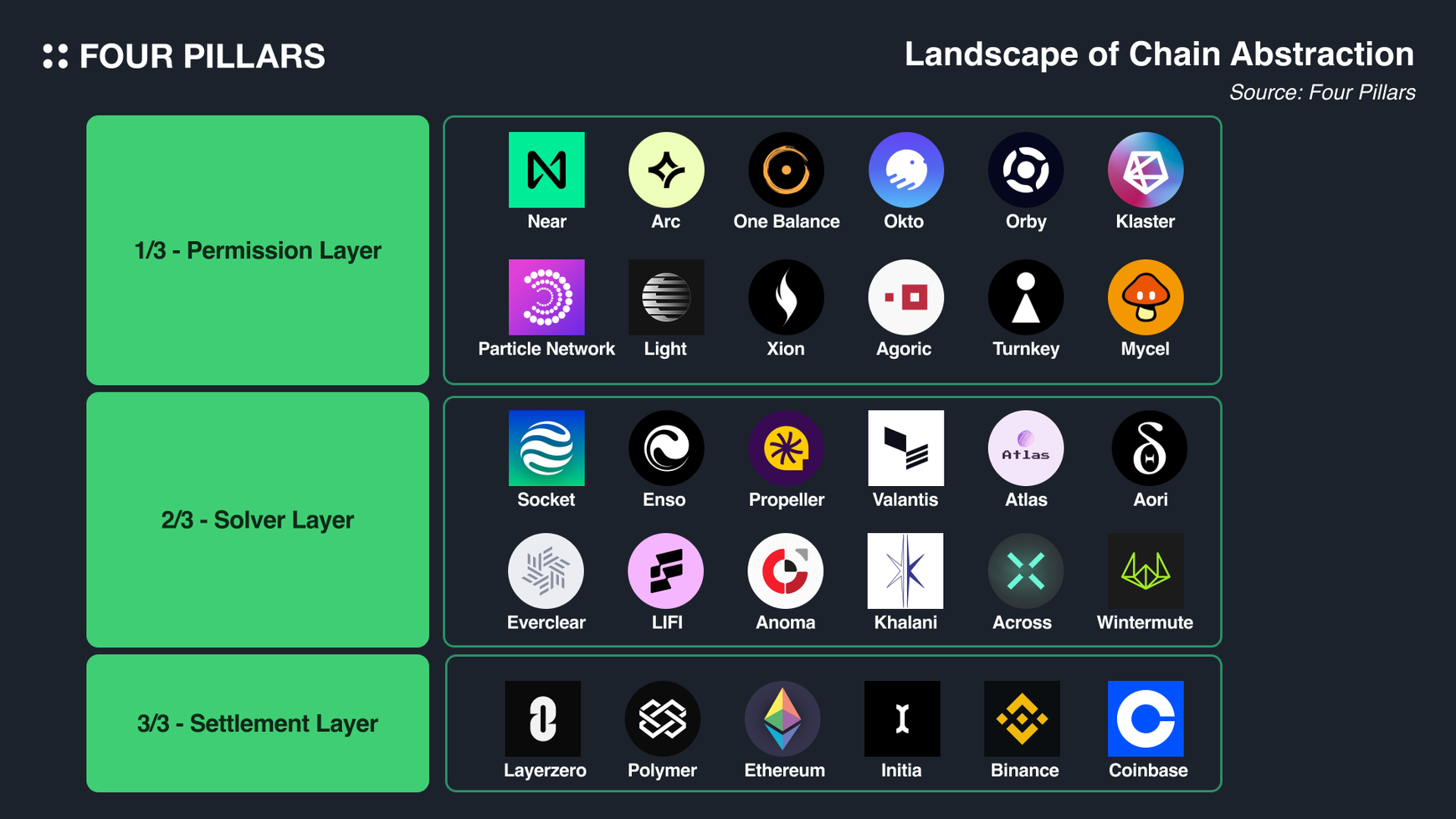
The user needs to understand lots of apsects of blockchain to start navigate the ecosystem. Also, it is essential to understand how each blockchain differ, as each has different account state, how contracts are deployed, etc. This means that as we are entering the phase of 1000 independent blockchains and rollups, these issues will get worse.
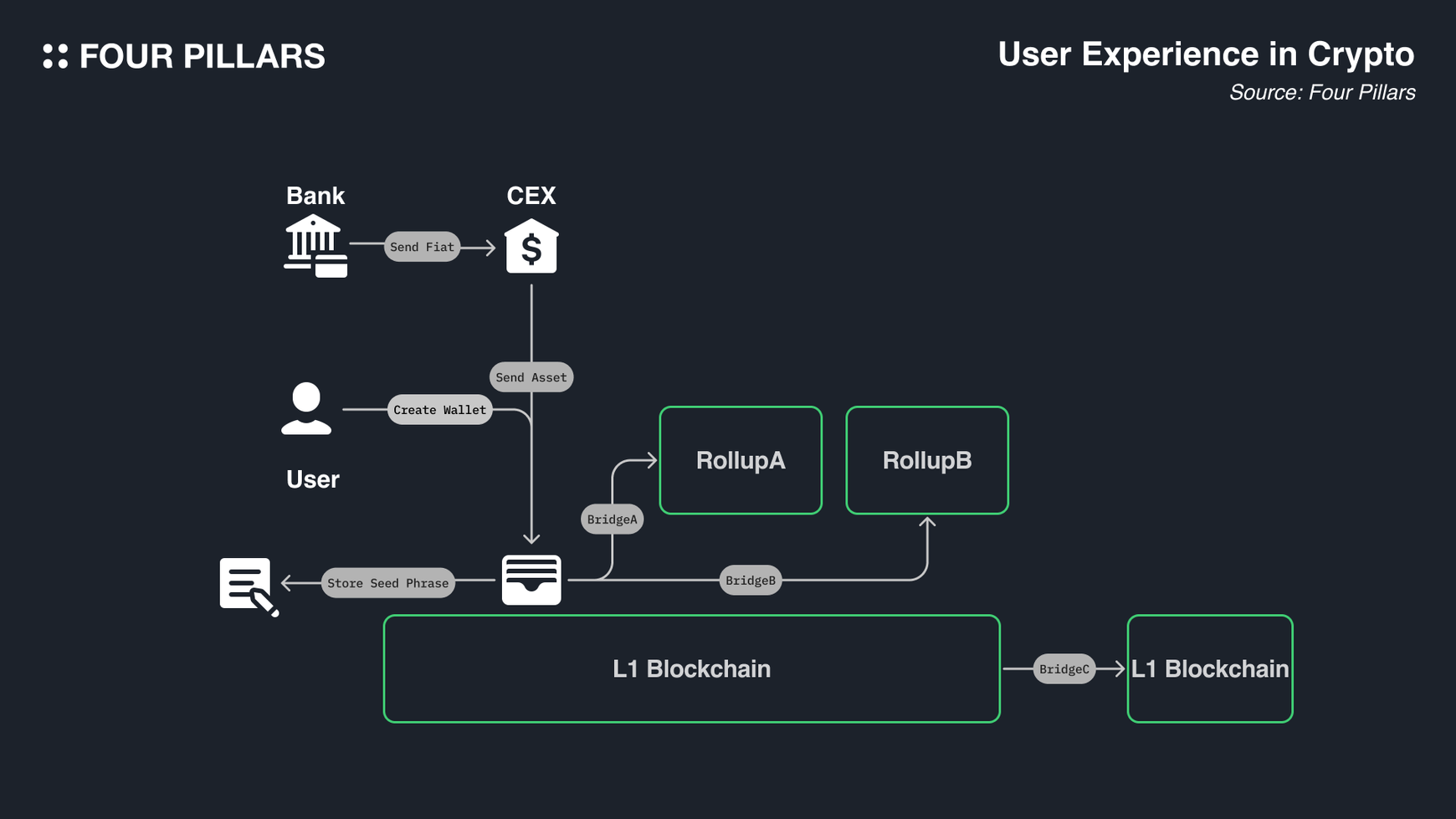
The user experience in the crypto ecosystem involves can be broken down into below steps:
Creating a Wallet: To start using blockchain, the first step is to create a wallet. This can be done through various wallet providers.
Storing a Seed Phrase: Upon creating a wallet, users are provided with a seed phrase, which is a sequence of words that acts as a backup to restore access to the wallet. It’s crucial to store this seed phrase securely, as anyone with access to it can control the associated assets.
Moving Assets On-Chain: Once the wallet is set up and secured, users can move their assets onto the blockchain by transferring them to the wallet's address. Each transaction requires a fee denominated in ETH or the native gas token. This process can involve buying an asset in CEX, and sending onchain. However, for blockchains and rollups that are not supported by the exchange, users need to find the right bridge service to send it.
Finding a dApp to Interact With: Dapps allow users to engage with various services like DeFi, NFTs, gaming, and more. Users can access these dApps through online searching or recommendation page from the wallet provider.
Managing Assets and dApps in a Single Blockchain: Managing assets and interacting with dApps involves using the wallet to approve and monitor transactions and smart contracts. Wallets typically provide functionalities to check balances, track transaction history, and interact with dApps. Some wallets provide the dashboard to track assets in dapps, for example a LP position in AMM DEX, but currently, no single provider captures all the dapps.
Managing Assets and dApps in a Different Blockchain: As there are multiple blockchains, over 100, users often find themselves interacting with various networks, each with its own set of dApps and tokens. This means that users must navigate different wallet interfaces, blockchain explorers, and token standards, which can be demanding and time-consuming. One of the key challenges in managing assets across multiple blockchains is that balances are isolated states across chains. This isolation means that users need to keep track of their assets on each blockchain separately, requiring multiple wallets. Additionally, moving assets between chains typically involves using cross-chain bridges or exchanges.
The user experience in crypto is less than ideal. It requires extensive knowledge for beginners, and there are multiple security risks and unique account structures and key management in each ecosystem. The numerous blockchains and assets, fragmented across different environments, can overwhelm users. Various attempts have been made to address these issues. Let's examine these past efforts.
There have been many different approaches to help users navigate the complicated crypto landscape. Some of the ones are like below:
1.2.1 Account Abstraction
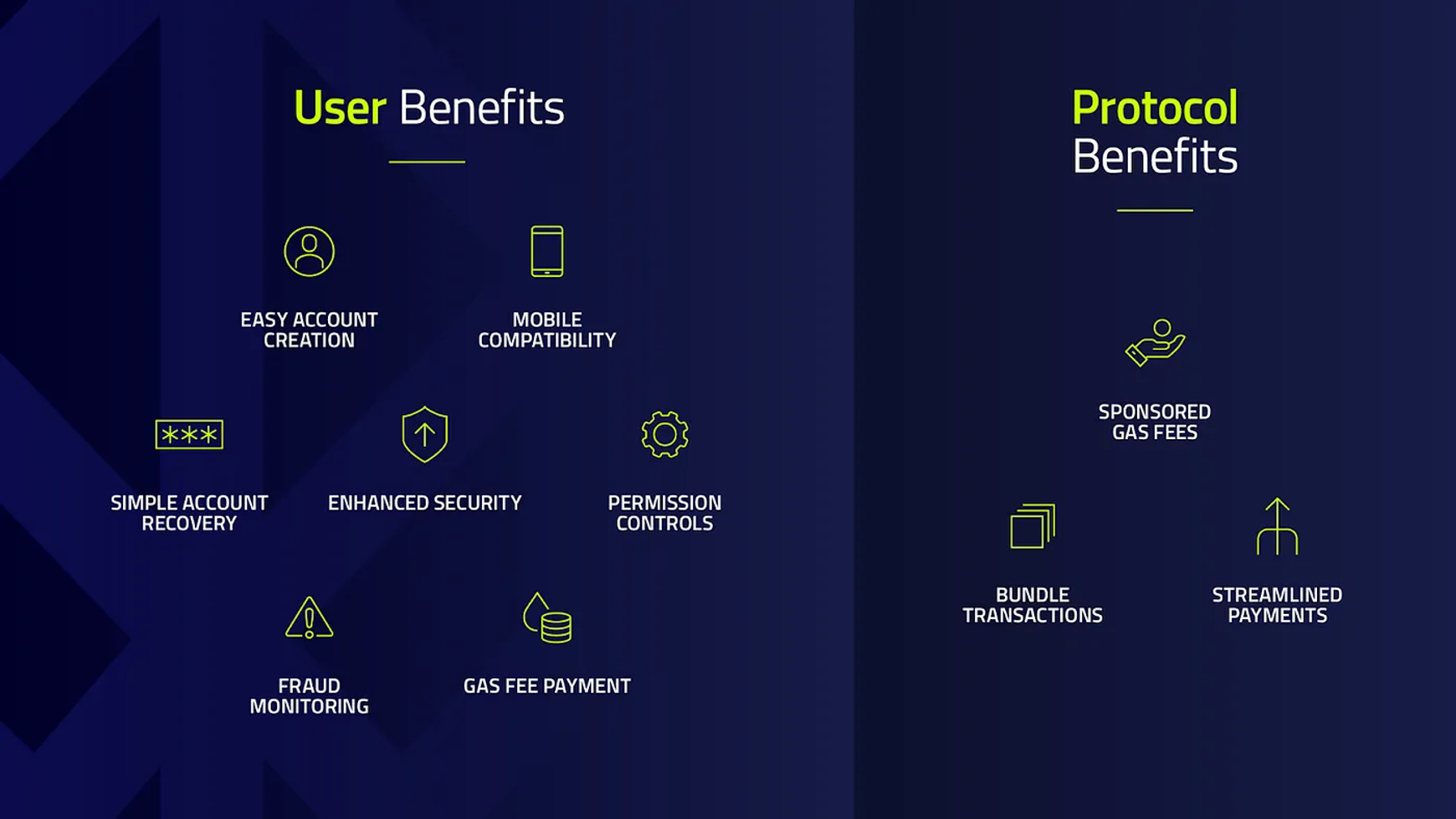
Source: The Next Billion Users: Exploring ERC-4337 Account Abstraction
Account abstraction brings several key benefits to the table. It simplifies interactions with blockchain networks by abstracting away complexities like key management and transaction rules.
In addition, account abstraction bolsters security features. With each account acting as a smart contract, it can define its own logic for transaction validation and execution. This opens up possibilities for advanced security measures such as multi-signature requirements, conditional transactions based on triggers, and spending limits, among others. Users get the flexibility to tailor security settings to their specific needs, enhancing protection against unauthorized access or transactions.
Account abstraction also introduces flexible signer options. The entity responsible for authorizing transactions, or the signer, can be an externally owned account, a custodial service, or a multi-party computation service.
Another notable feature, and the most used feature is the provision for gas sponsorship. This allows entities to sponsor gas fees for transactions, making the user experience more seamless, especially when onboarding new users. Services like Gelato and Alchemy's Gas Manager API are instrumental in this regard, as they sponsor gas fees for user operations.
Lastly, account abstraction supports the batching of transactions. This feature allows for multiple transactions to be grouped into a single operation, optimizing efficiency and enhancing the user experience. This leads to more streamlined and cost-effective transaction processing.
1.2.2 Bridging - Sending Assets to Other Blockchains

Source: What are Cross-chain bridges? A Detailed Guide
Crypto asset bridges are protocols that facilitate the transfer of digital assets across various blockchain networks, providing cross-chain interoperability and connectivity. These bridges unlock liquidity that was previously confined within individual chains, allowing users to move their assets freely between different blockchain ecosystems. This increased capital efficiency enables users to access a variety of dApps, liquidity pools, and investment opportunities across multiple networks.
Aggregation services such as LIFI, Bungee, and Squid are designed to streamline and optimize the process of transferring assets across different blockchains. These aggregators connect to multiple blockchain bridges and DEXs to provide users with the most efficient routes for their cross-chain transactions. These services simplify the process of finding the right bridge and conducting multiple cross-chain swaps.
1.2.3 Additional Initiatives to Enhance the Crypto Experience
Additionally, various efforts had been made to improve the overall experience for cryptocurrency users, addressing key areas such as address readability, portfolio management, and user interface enhancements.
Ethereum Name Service (ENS): The Ethereum Name Service (ENS) is a naming system that resolves difficult-to-read and often complex cryptocurrency addresses into readable, user-friendly names. This significantly simplifies transactions and improves user interaction by allowing individuals to use easily memorable names instead of long hexadecimal addresses. This is getting more adoption, for example uniswap web3 username.
Portfolio Management Tools: Platforms like Zerion and DeBank have enhanced how users manage and monitor their crypto assets within the Ethereum ecosystem. These services offer dashboards where individuals can view and analyze their entire portfolio, track which protocols their assets are deposited on.
Wallet Management through Social Login: This feature allows users to create and manage their crypto accounts through their social media accounts like google, twitter, etc. It enhances user experience by simplifying the process of logging in, eliminating the need to remember complex passwords or keys. It also provides an additional layer of security as social media platforms have their own robust security mechanisms. Projects that provide this service include Particle Network’s WaaS, Privy, and Web3Authn.
Enhanced User Interfaces: One of the primary focus areas in the enhancement of the crypto experience is the development of more intuitive and user-friendly interfaces. There are lots of designers trying to make the experience smoother. (Example1. Design Exploration: Cross-Chain Asset Fragmentation | Galaxy, Example2. Family Wallet)
When it comes to projects related to crypto UX, they are often fragmented. No single solution is comprehensive, making it challenging to unify them in one diagram. For instance, when a new rollup launches, it must partner with many vendors to begin operating its infrastructure. The developer of the rollup must liaise with projects building user infrastructure that have overlapping offerings. It begs the question, why can't we have a single integration stack or a mental model to streamline the onboarding process?
Many attempts to improve UX ironically make it more complex for users to navigate and developers to understand. This observation is not intended to criticize the efforts in this field. Instead, it emphasizes the need for a unified mental model that encompasses all solutions to align with the overarching goal - "Improving User Experience in Multichain Ecosystem." As there are more than 100 blockchains that are planned to launch soon, this initiative is now getting clearer through a narrative and tech stack known as "Chain Abstraction."
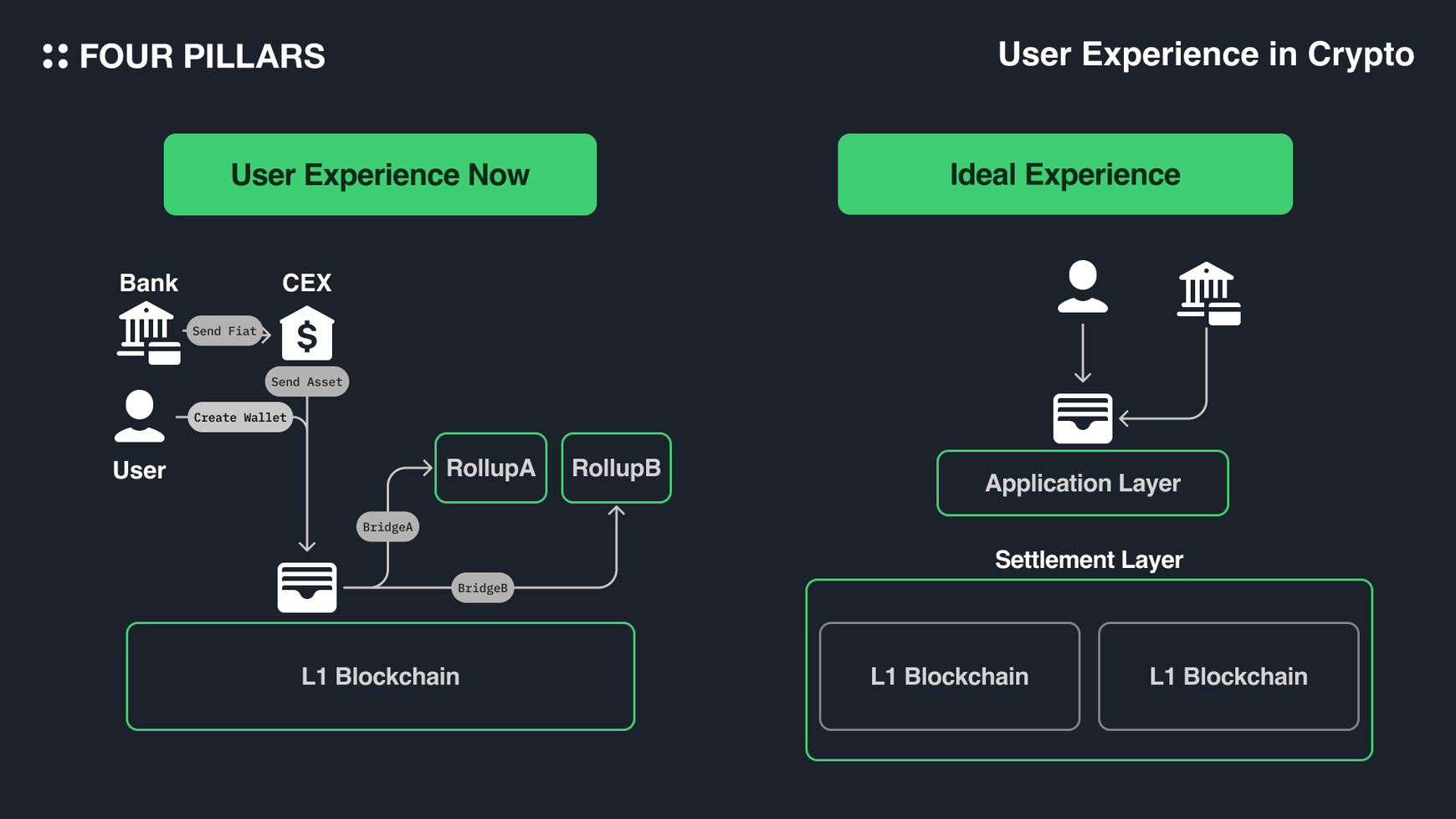
To make the user experience better, there is a necessity to abstract away the complexities. This is where the chain abstraction comes in, a new narrative and a tech stack that involves abstracting away a certain interaction that occurs onchain. This narrative was first asserted by Connext (now known as Everclear), and have been specified by Ankit Chiplunkar and Stephane Gosselin from Frontier Research.
Last February, Frontier Research released an article “Introducing the CAKE framework” that outlined the Key Elements and Components of Chain Abstraction. From then, related projects around it started to form the narrative to better solve the fragmented user experience and developer experience, with some of the leading projects like Particle Network and Near Protocol.
In this part, let’s look into what Chain Abstraction and CAKE Framework is.
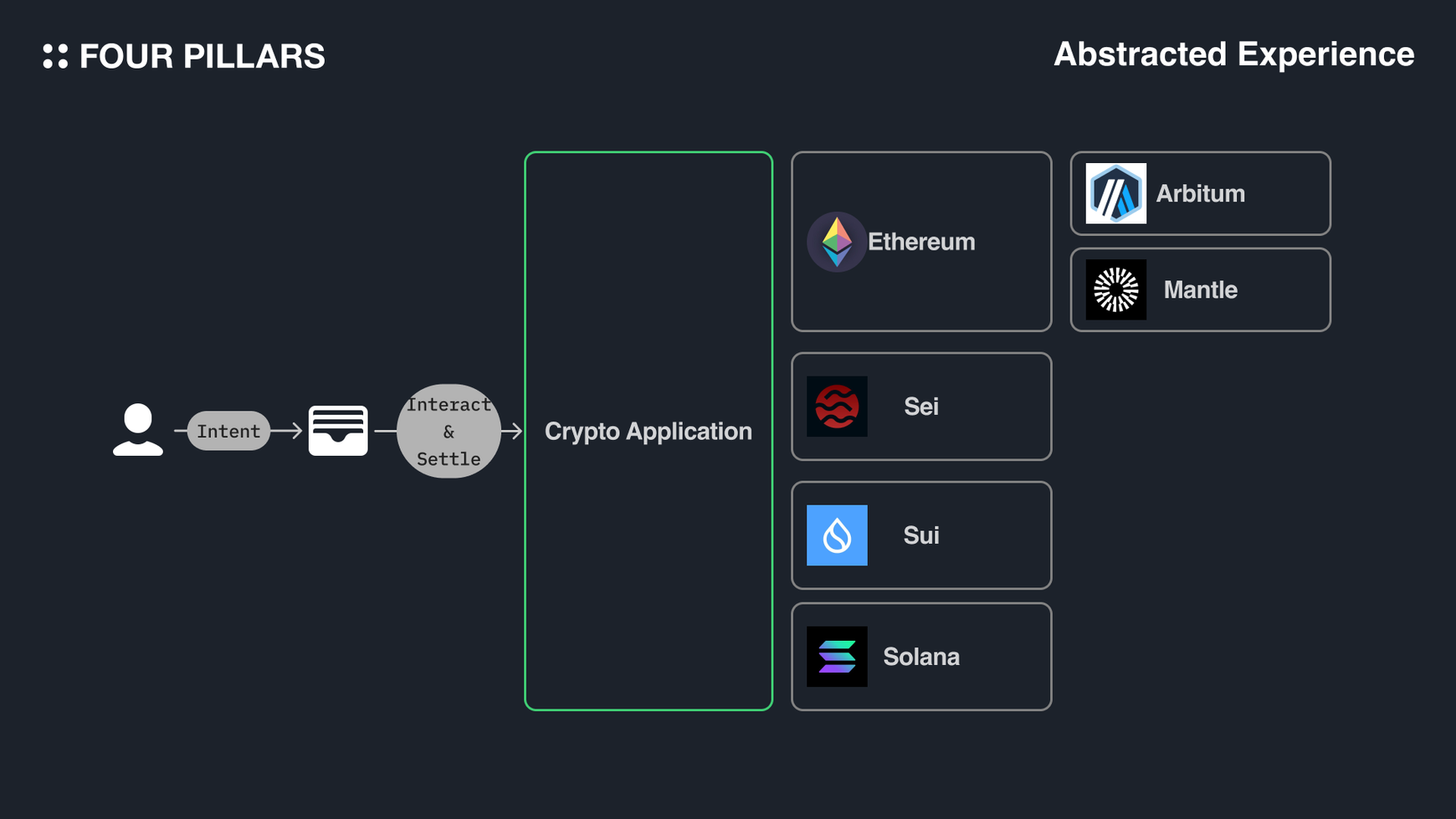
“Chain Abstraction,” from its words, are the narrative and the tech stack that abstracts the complexity in the user operation in the multichain ecosystem. In this section, lets see in which interactions can be abstracted away. The Chain Abstraction movement aims to simplify and streamline the user experience when interacting with blockchain technology by abstracting away various complexities. Here are some processes that can be abstracted away:
2.1.1 Abstract the Complex Onboarding Process
Key Management Abstraction: Users do not need to manage private keys or seed phrases manually in each blockchain, as the system handles key generation, storage, and signing transactions securely.
Gas Abstraction: Users can perform transactions without needing to acquire and manage separate gas tokens for each blockchains.
2.1.2 Abstract the Complex Interaction with Dapps
Asset Management Abstraction: Users can manage and interact with their assets across different blockchain networks through a single interface, without needing to understand the technical details of each network.
Transaction Abstraction: Users can initiate transactions without needing to understand the underlying blockchain protocols, as the system bundles and processes transactions in batches.
2.1.3 Abstract the Complex Interactions with 1000+ Blockchains
Token Bridge Abstraction: Users can seamlessly transfer assets across different blockchain networks without needing to understand the technical details of blockchain bridges or wrapped tokens.
Multi-Chain Abstraction: Users can interact with smart contracts and applications across multiple blockchain networks through a unified interface, without needing to switch between different wallets or interfaces. This can be done with message bridges, or a solver.
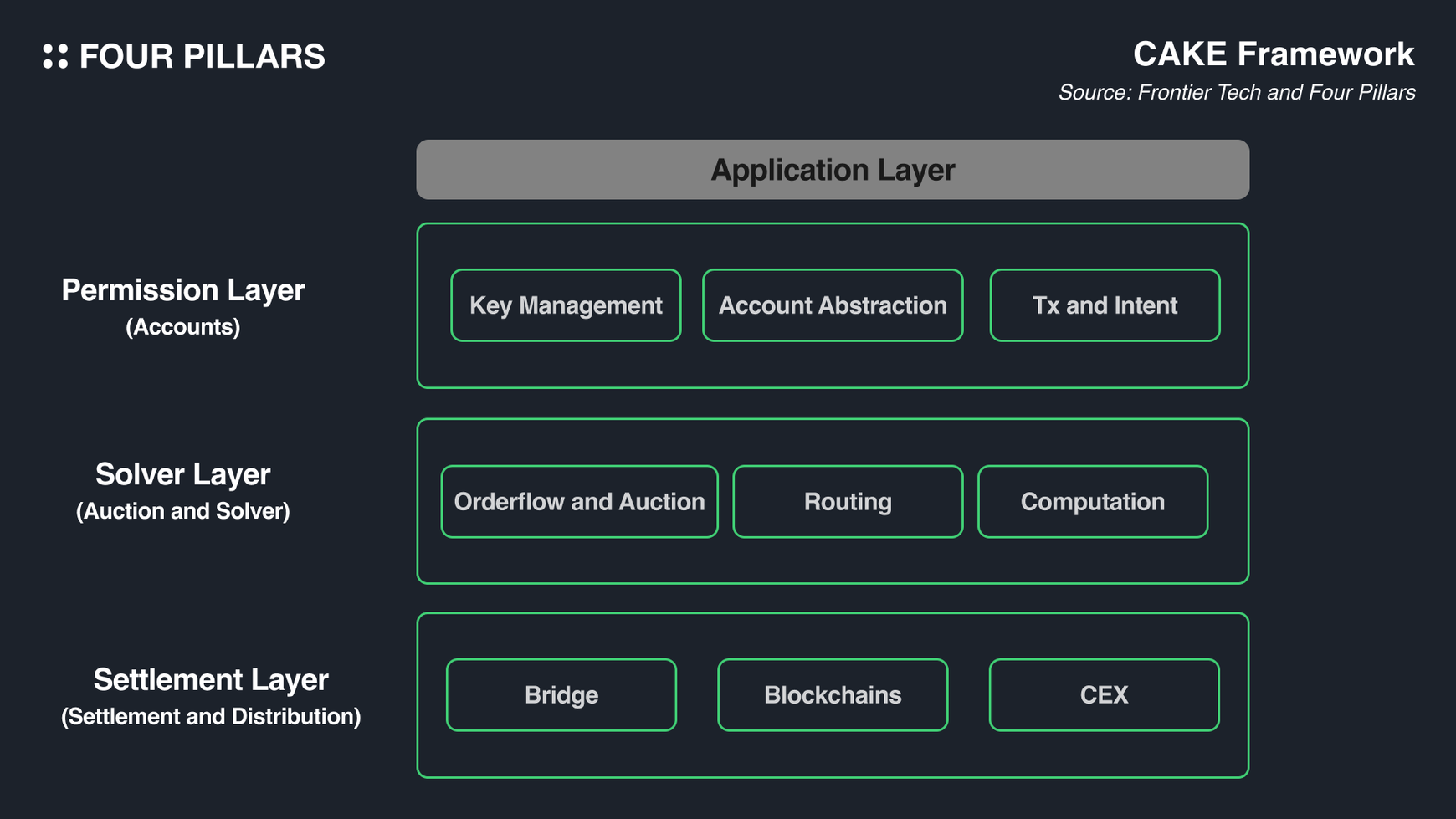
Source: Introducing the CAKE framework by Frontier Tech
The CAKE (Chain Abstraction Key Elements) framework is an approach designed to simplify user interactions with blockchain networks by abstracting away the complexities associated with different blockchain ecosystems.
The framework seeks to make the overall process of interactions more clearer, making different providers to coordinate, and help users to understand which projects handle which operations. The intricate processes involving interactions on various chains and the actual transaction execution can be handled behind the scenes within the infrastructure layers of CAKE.
The CAKE framework is structured into three layers - Permissions, Solver, and Settlement.
Permission Layer: This layer focuses on the user's interactions with a dApp and the authorization of intents, such as transfers and investments. This layer is responsible for authorizing the usage of user's assets and executing transactions across different target chains.
Solver Layer: The Solver layer then estimates the fees and execution speed based on the user’s initial balance and intent. It addresses the challenges of asynchronous cross-chain transactions where sub-transactions might fail, making the middlemen, solvers essential for estimating and handling these variables efficiently.
Settlement Layer: Once the user authorizes a transaction, the Settlement layer ensures the completion of the operation. This involves bridging the user’s assets to the target chain and executing the intended operation.
An orchestration of these three layers—Permission, Solver, and Settlement—is key to achieving comprehensive chain abstraction, allowing for a seamless and user-friendly experience.
Ultimately, the CAKE framework’s goal lies on industry-wide coordination, ensuring consistent and efficient interactions across different blockchain ecosystems.
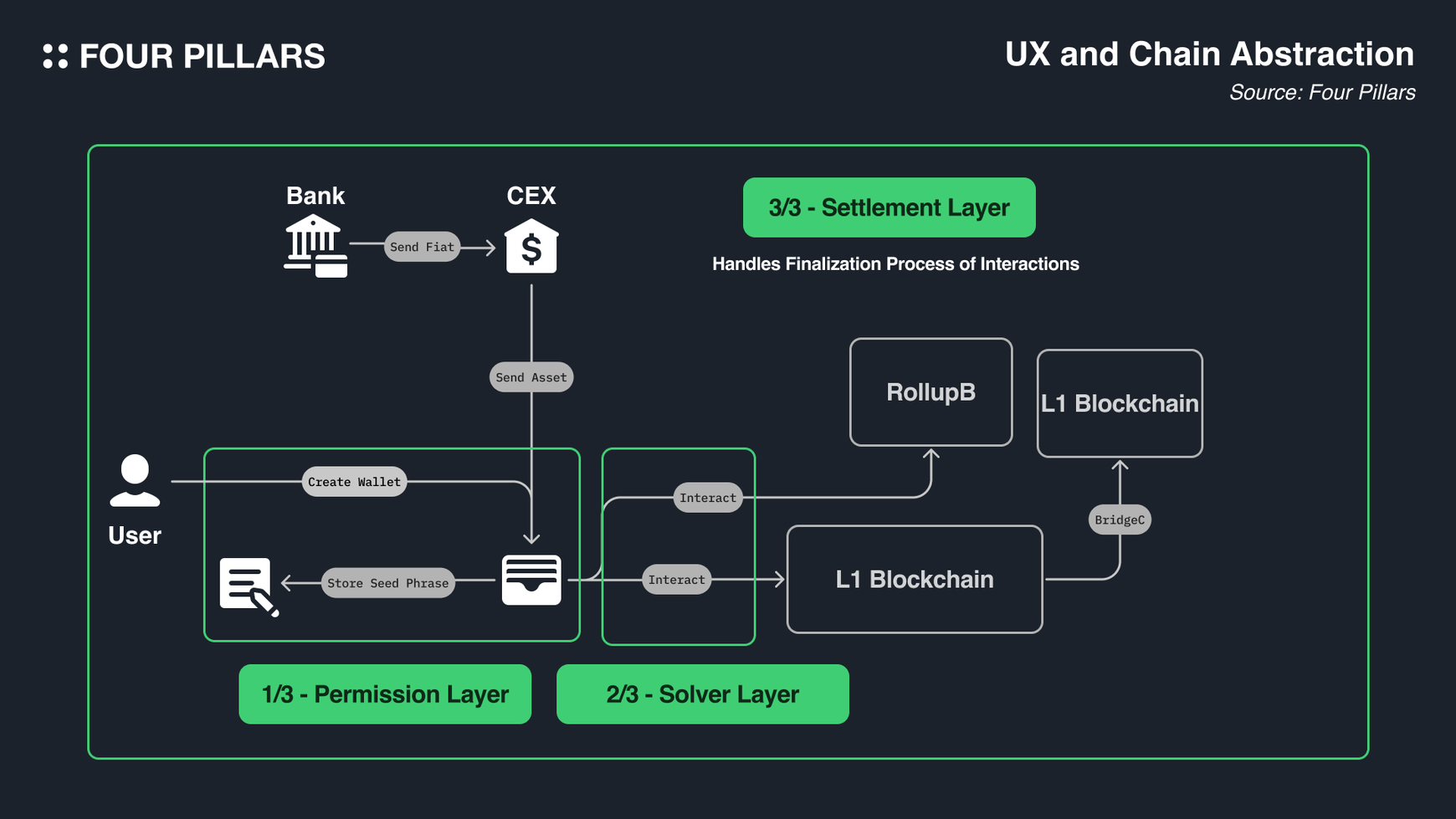
In this part, let’s look into what projects are building to enable chain abstraction and dive deeper into what sub categories are in each layers.
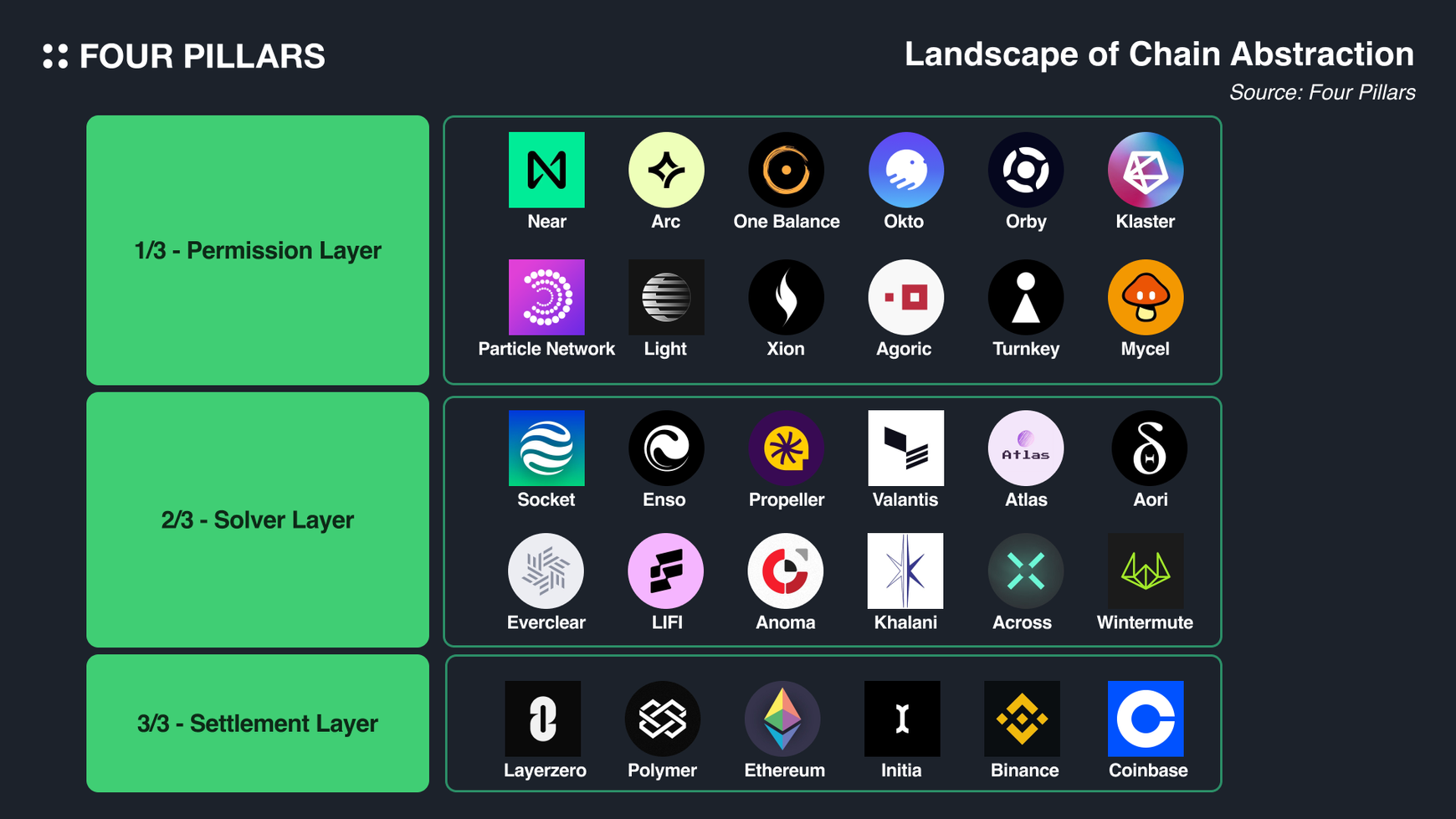
The Permission Layer plays an essential role in defining the ways users authorize and interact with various blockchains. It facilitates the secure management of accounts and the efficient expression of user intents across multiple protocols. This section examines the different aspects of key management, signature abstraction, and gas/asset abstraction. Subsectors in the Permission Layer are:
3.1.1 Key Management/Signature Abstraction
Near Protocol Chain Signature: A Chain Signature refers to a mechanism that enables NEAR accounts to sign and execute transactions across multiple blockchain protocols. To create a Chain Signature, the process starts with deriving the foreign address, which involves using the NEAR account, a specified derivation path, and the MPC service's public key to deterministically generate an address on the target blockchain. Transactions are then constructed according to the specific requirements of the target blockchain, such as Ethereum or Bitcoin, and the payload is created. The NEAR account requests a signature from the multichain MPC smart contract, which recursively calls itself until the MPC service signs the transaction. The signature is then reconstructed from the response elements returned by the contract, and this reconstructed signature is relayed to the target blockchain for execution.
Xion: XION's chain abstraction extends beyond simplifying user interactions within its own ecosystem. It also facilitates seamless interoperability across different blockchain networks. By integrating with other blockchains, such as Injective, XION enables users to interact with dApps across multiple ecosystems without dealing with cross-chain bridging, gas fees, or complex transaction signing.
3.1.2 Gas/Asset Abstraction
Particle Network: It offers Universal Gas and Universal Liquidity features. Universal Gas allows users to pay gas fees for cross-chain transactions using any token, eliminating the need for multiple native gas tokens (e.g., ETH, SOL, MATIC) across different chains. Universal Liquidity, on the other hand, unifies the liquidity of all connected chains through optimistic execution of cross-chain atomic transactions and swaps, enabling users to interact with new chains without holding tokens on those specific networks. Particle Network also supports Universal Account, which allows users to manage a single address and balance across various blockchains.
One Balance: OneBalance is designed to create and manage what are termed as "Credible Accounts." This new model abstracts the complexities of managing various assets and operations on different chains, allowing users to consolidate token balances from every chain, abstract gas fees, and perform cross-chain swaps and transactions effortlessly. Central to the functionality of OneBalance are "resource locks," which are commitments made by users to lock certain states, analogous to depositing funds in a smart contract, but without needing on-chain finality immediately. This mechanism prevents issues like double spending and request equivocation by enabling asynchronous state transitions across chains.
Socket Protocol Magic Spend++: It is a smart wallet framework that eliminates the complexities of handling fragmented assets across multiple blockchain rollups. MagicSpend++ leverages the Account Abstraction standard to provide an user-friendly experience where users can transact on any blockchain without worrying about the location of their tokens. By introducing a Chain Abstracted Balance (CAB), MagicSpend++ aggregates all user assets into a single balance that can be utilized across any chain with just a signature.
The Solver Layer manages the execution of the user requests. The intermediary, solvers, operate to optimize operations and maximize values for the users. This section explores the various components and subsectors involved in the Solver Layer's auction market. Subsectors in the Solver Layer includes:
3.2.1 Transaction Abstraction
Enso Network: Enso Network is a unifying connectivity layer in the crypto ecosystem. By maintaining a shared network state, Enso allows state data across various blockchains to be aggregated and represented as entities in a unified graph. This eliminates the need for developers to create manual integrations for each smart contract and protocol. Each entity in the Enso Network includes detailed information on action types such as Lend, Borrow, Swap, etc., enabling efficient data consumption and integration. Developers can express desired outcomes using intent requests that span multiple blockchain frameworks, and Enso Network participants craft solutions to fulfill these intents.
Atlas EVM: Atlas is a framework designed for Execution Abstraction. At its core, Atlas enables dapps to run auctions that pair User Operations with Solver Operations, optimizing task fulfillment and maximizing miner-extractable value (MEV). Atlas functions by combining User Operations collected via the Atlas SDK with Solver Operations into a single transaction mediated by a designated Operations Relay, which can include network options like BloXroute, SUAVE, or on-chain alternatives. A key advantage of Atlas is its trustless execution environment, allowing each frontend to customize auction parameters and value allocation according to their specific needs.
3.2.2 Auction Market
Socket Protocol MOFA: The Modular Order Flow Auction (MOFA) functions as an open marketplace where execution agents, or transmitters, to fulfill off-chain user requests, which are essentially signed user intents, by settling them on-chain. This competition among transmitters ensures that users achieve the best possible execution for their interactions, irrespective of the specific blockchain involved.
Across: It is an interoperability solution that facilitates fast cross-chain asset transfers through an intent-based design. Its architecture consists of three main components: a request for quote mechanism where users express their intents, a network of competitive relayers who compete to fulfill these intents quickly and efficiently, and a settlement layer that escrows user funds, verifies the successful completion of intents, and repays the relayers accordingly.
3.2.3 Solver Infrastructure Network
Khalini: Khalani Network is a decentralized infrastructure designed for intent-driven coordination. Khalani's architecture It is built around three core components: the intent compatibility layer, Validity VM (VVM), and the universal settlement layer. The intent compatibility layer standardizes and publishes intents to facilitate collaborative solving by solvers. Validity, a specialized language and runtime, provides an environment for general-purpose intent processing with deterministic settlement guarantees. The universal settlement layer enables atomic and multi-domain settlements, effectively integrating Khalani into various intent-centric applications and ecosystems
Essential: Unlike traditional blockchains that rely on imperative programming, which requires specifying exact steps to achieve desired outcomes, Essential leverages a declarative approach. where users can specify the desired outcomes directly rather than the paths to those outcomes. Essential’s tech stack is built around two core components: an executionless blockchain,a network of solvers. The executionless blockchain increases throughput and reduces costs by offloading the computationally intensive task of finding optimal state updates to off-chain solvers while keeping the verification process simple and on-chain. The solver network competitively finds the best solutions to user intents, ensuring optimal outcomes.
3.2.4 Clearing Layer
EverClear: Formerly known as Connext, is a clearing layer that calculates and nets incoming and outgoing token bridge transactions. Everclear's data analysis shows that, on average, approximately 80% of daily cross-chain capital flows can be netted. For every $1 bridged into a chain, $0.8 is bridged out. The core architecture of Everclear involves solvers (liquidity providers), relayers (who execute transactions on behalf of users), and Watchers (who monitor for fraud). By incorporating a customized Arbitrum Orbit rollup, Everclear optimizes the auction and verification of transaction batches.
The Settlement Layer is crucial in ensuring the finality and immutability of transactions. It serves as the cornerstone for validating and securing transactions. This section delves into the components involved in the Settlement Layer. Subsectors in the Settlement Layer includes:
3.3.1 Blockchains and Bridges
L1 Blockchain: L1 blockchains serve as the base settlement layer, providing the foundation for secure and immutable transactions. The L1 blockchain directly processes and secures all transactions through its consensus mechanism. Each blockchains have their unique finalization method and separate state.
L2 Blockchain: L2 rollups offload some transaction processing from its L1. However, L2 rollups rely on the security of the underlying L1 blockchain, periodically anchoring transaction data to the L1 chain to ensure finality.
Bridges and AMB: The token bridges and messaging bridges transport data from one blockchain to other, in a secure way. This message transfer is crucial to manage assets in multiple blockchains and to check the finalization of the execution.
3.3.2 CEX and On/Offramp
Coinbase: CEX handles the incoming and the outgoing crypto assets and finalize the transactions in their platform. Also Coinbase connects the coinbase account with a bank account so that users can send US dollars.
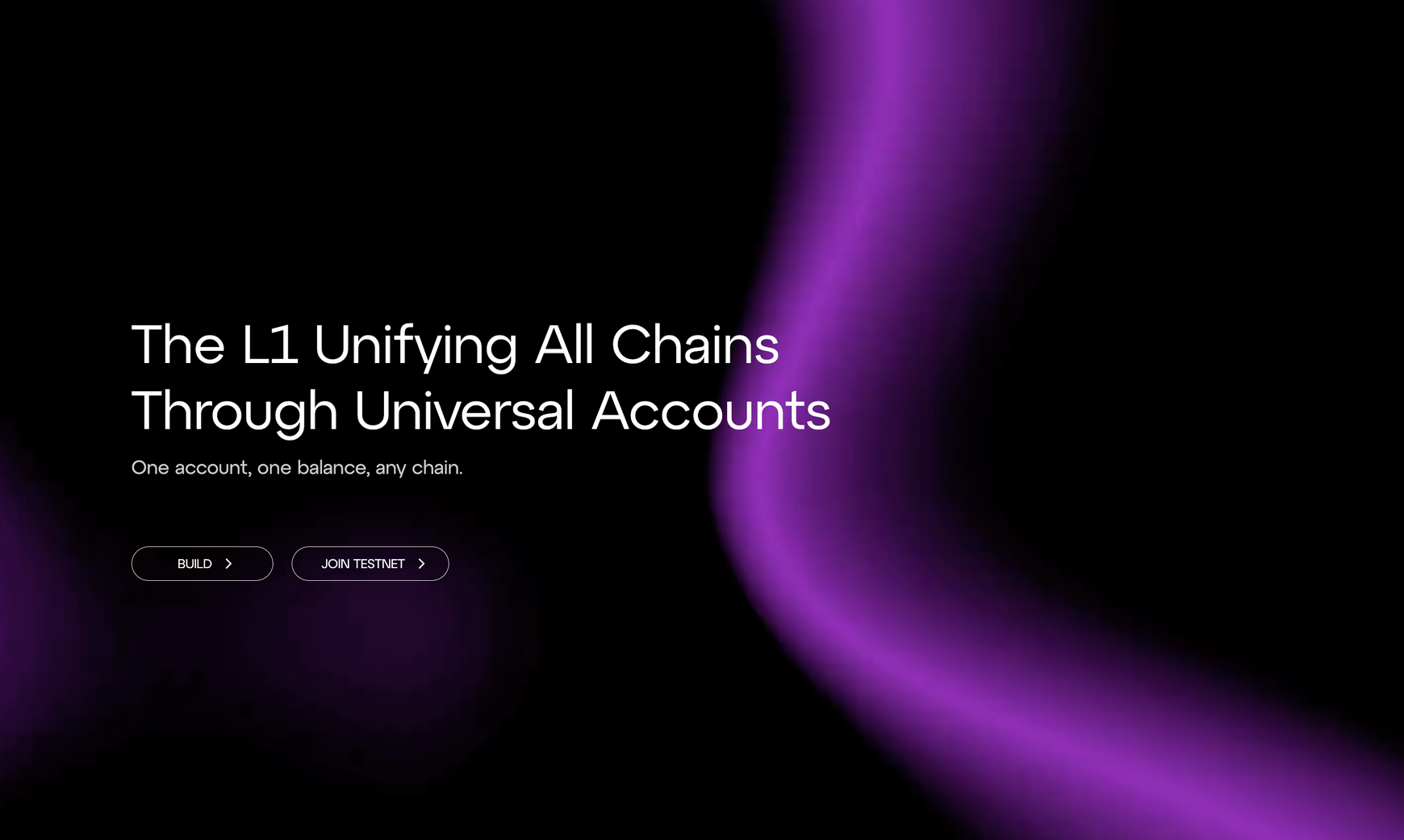
Source: Particle Network
Particle Network has been one of the earliest and consistent protocol that has tried to make the user experience better in crypto. From a SDK to create a wallet from a social login, know they are focused on abstracting the complex process for users. Its Layer 1 blockchain is focused on providing chain abstraction solutions to allow users to use one account and one balance applicable to all chains, with their “Universal Account” technologies.
It tackles various aspects of chain abstraction, including account management, gas payments, liquidity, and transaction settlement. Here's how Particle Network addresses different aspects of chain abstraction:
Chain Abstraction: Particle Network offers a modular Layer 1 architecture built on the Cosmos SDK, allowing it to connect to various environments like EVM, BTC UTXO, and Solana.
Universal Accounts: Particle Network introduces Universal Accounts, which act as a single account interface for users to interact with multiple chains seamlessly. Users can access these accounts by connecting an existing wallet, allowing them to execute transactions using balances sourced from any chain.
Gas Abstraction: Particle Network offers gas abstraction through its Universal Gas, which allows users to use the token of their choice to pay for the gas fees. The tokens can be located in any blockchains.
Liquidity Abstraction: Particle Network aggregates on-chain and off-chain data liquidity through its Universal Liquidity. It allows users to combine their assets in multiple blockchains, and use any assets as a gas fee, or an asset to interact with the dapps or pay the gas. For example, with the ARB in Artbirum, users can deposit to a Lending pool in Seamless Protocol in Base Network.
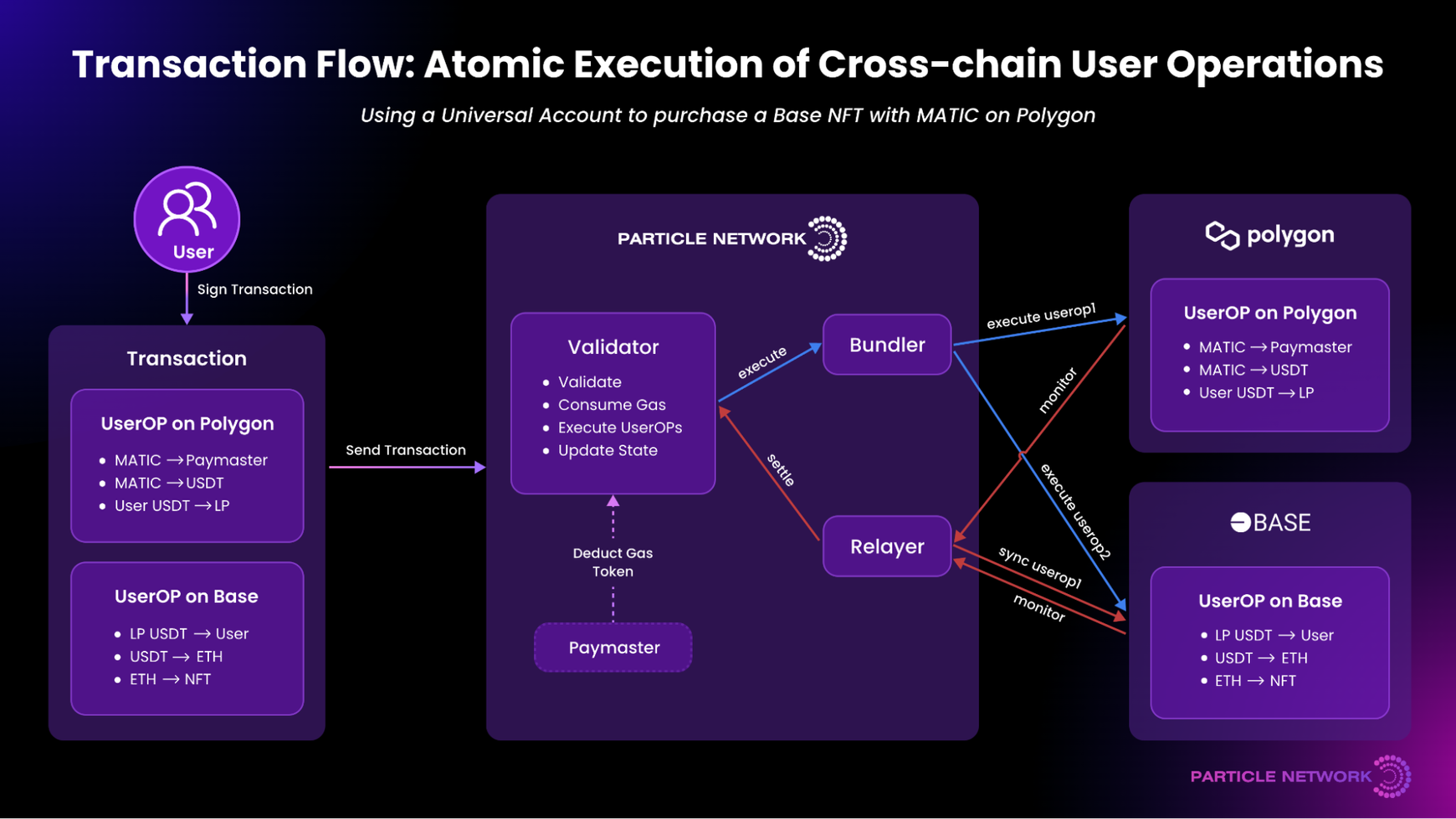
Source: Chain Abstraction: Multi-Faceted Landscape Report
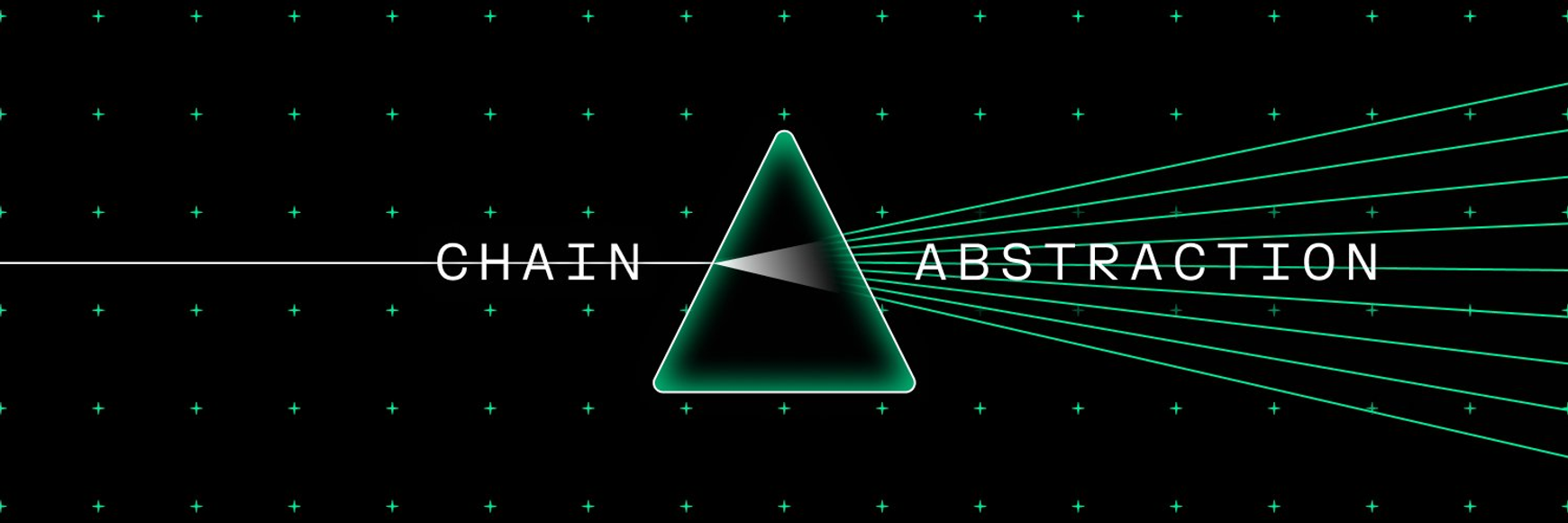
NEAR Protocol, with their Chain Abstraction infrastructure in its L1, aims to simplify the user experience across multiple blockchains. The core idea is to abstract away the underlying complexities of different blockchains, allowing users to interact with various chains using a single NEAR account. This account serves as a unified identity for the user, eliminating the need to create and manage separate accounts for each blockchain. This has been possible with Near’s Chain Signatures.
4.2.1 Chain Signature

Source: What are Chain Signatures? | NEAR Documentation
Chain signatures allow a NEAR account to sign transactions on other blockchain networks without requiring the user to hold the private key for those networks. This is achieved through a process called Multi-Party Computation (MPC). The key components for this Chain Signature involves:
MPC-based Key: When a NEAR account is created, the user's private key is generated using MPC. This means that the private key is never stored in its entirety on any single device or server.
Smart Contract Signatures: NEAR Protocol utilizes smart contracts deployed on the target blockchain networks (e.g., Ethereum, Avalanche) to generate signatures for transactions initiated by the NEAR account. These smart contracts are designed to accept and validate signatures generated by the NEAR account's MPC-based private key.
Indexers and Relayers: NEAR Protocol employs indexers that monitor the target blockchain networks for signatures generated by the NEAR account's smart contracts. Once a valid signature is detected, relayers pick up the transaction and submit it to the respective blockchain network for execution.
Intent Relayers: It facilitates cross-chain transactions by handling the conversion of tokens and gas fees between different blockchain networks. When a user initiates a transaction on a blockchain network other than NEAR, the intent relayer automatically converts the required tokens and gas fees from the user's NEAR account balance.
As blockchain ecosystems continue to evolve, their complexity is growing exponentially, making navigating multiple blockchains increasingly challenging for users. The increase in new blockchain and rollup experiments further compounds this issue. However, there are ongoing development of products designed to simplify user interactions and make them more intuitive. Platforms like Strateg, a multichain yield abstraction protocol, exemplify this attempt. Such platform allows users to easily earn yields from diverse sources using any of their tokens, in any supported blockchain.
To form a mental model on the technical stacks of these abstractions, "Chain Abstraction" comes into play. The narrative of Chain Abstraction will stay and there will be more projects, trying to solve the similar problem with different approaches. As the development phase is still early, this kind of experiments and competition will grow. However, the unique aspect of this trend is that projects aim to coordinate and support each other's developments. They share a common vision to make interaction with hundreds of blockchains more manageable.
To achieve this vision, I hope the coordination works not in a fragmented way, but in a coordinated way.
*Special thanks to Tabasco from Particle Network, Scott from Near Protocol and Arjun from LIFI for the discussion and inspiration for this article, and also thanks to VC from Socket Protocol, for creating an awesome repositories on Chain Abstraction related (Twitter List)
Thanks to Kate for designing the graphics for this article.
Dive into 'Narratives' that will be important in the next year